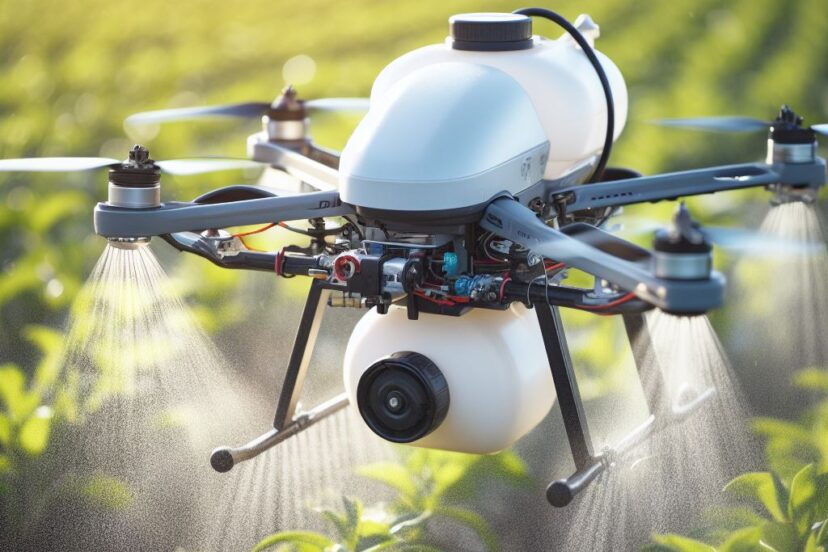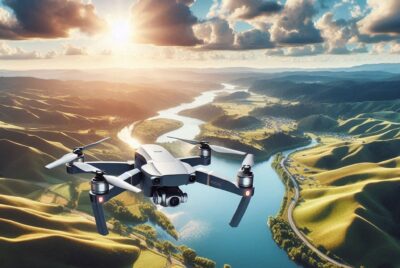Drone Sprayer: Revolutionizing Agricultural Efficiency
*We may earn a commission for purchases made using our links. Please see our disclosure to learn more.
Drone Sprayer Efficiency: Revolutionizing Precision Agriculture
I’ve been exploring the burgeoning field of agricultural technology, and one development that stands out is the use of a drone sprayer. These drones represent a significant advancement in precision agriculture, utilizing cutting-edge tech to enhance operational efficiency on the farm. Unlike traditional methods of crop treatment, drone sprayers can access difficult terrain, reduce labor requirements, and minimize exposure to chemicals for workers.

Through the integration of advanced sensors and GPS technology, these drones deliver treatments directly where they are needed, in the exact doses required, ensuring minimal wastage and environmental impact. I’ve learned that agricultural drone solutions, such as those offered by companies like DJI and Agri Spray Drones, are equipped with features like adjustable arms and branch-targeting technology that significantly improve the coverage and uniformity of spraying applications.
Drone sprayers are not just about the application of liquids; they also handle granular substances and cover crops, making them versatile tools for a variety of agricultural needs. Their use is a testament to the ongoing evolution of ag-tech, where efficiency is continually being refined and enhanced to support sustainable farming practices. With these technologies at our fingertips, I’m confident that we’re witnessing a pivotal shift in how crop care is managed, leading to smarter, more responsible agriculture.
Overview of a Drone Sprayer

Drone sprayers represent a technological evolution in precision agriculture. They offer targeted application of pesticides, fertilizers, and herbicides from above, with particular benefits for large or difficult-to-access areas.
Advantages of a Drone Sprayer
Precision and Efficiency
- Targeted Application: I can ensure that spray drones deliver chemicals only to areas that need treatment, which minimizes waste.
- Safety: By handling potentially dangerous chemicals remotely, I minimize the risk to human operators and reduce exposure to the environment.
- Cost-Effectiveness: Operating drones generally costs less when compared to traditional methods, as they can cover large areas quickly and require fewer labor resources.
Technological Integration
- Advanced Mapping: Drone technology includes advanced mapping functionalities that allow me to analyze crop health and create precise spray paths.
- Real-Time Adjustments: Drones equipped with sensors can adjust spraying parameters on the fly, responding to real-time data to optimize coverage.
Key Components
Spraying System
- The tank, nozzles, and pump work in unison to deliver the liquid payload efficiently.
Navigation and Control
- Drones often integrate GPS and Real-Time Kinematics (RTK) for precise location tracking and navigation.
Energy Source
- The power for the drone, commonly through rechargeable batteries, determines its operational endurance.
Types of Drones for Spraying
- Multirotor Drones: These are suited for smaller fields or where detailed application is necessary.
- Fixed-Wing Drones: I use these for larger areas as they cover more ground quickly but require a space to take off and land.
- Helicopter Drones: They offer a balance between multirotor and fixed-wing types, with vertical takeoff and landing capabilities and efficient coverage for medium-sized areas.
Drone sprayers are continuously being refined to handle a range of agricultural tasks more effectively, making them an integral part of modern precision farming techniques.
The Technology Behind a Drone Sprayer

Drone sprayers utilize a combination of advanced aeronautics and precision agriculture technologies. I’ll delve into the specifics of their intelligent flight batteries, spraying systems, and navigation and mapping capacities that enable efficient and targeted application of agricultural products.
Intelligent Flight Battery
The lifeblood of any drone is its battery. Intelligent flight batteries are crucial for drone sprayers like the DJI T30 and T40 models, providing power not only for flight but also for spraying operations. These batteries feature:
- High-capacity: To ensure prolonged operation times.
- Quick-swap designs: For minimal downtime between charges.
- Intelligent management systems: These systems predict battery life and monitor health, keeping the drones operational for as long as possible.
Spraying System Technology
The spraying system technology in drone sprayers is at the core of their functionality. My focus is on:
- Precision nozzles and pumps: These are carefully calibrated to deliver a fine mist, reducing leakage and ensuring an even coating over the crops.
- Variable spray modules: These allow for the adjustment of the spray’s volume and pattern to match the treatment needs.
- Active phased array radar: This radar system permits the spraying system to adapt its operation based on the target’s distance, increasing accuracy and efficiency.
Navigation and Mapping
Drone sprayers harness sophisticated navigation and mapping technologies to operate autonomously over agricultural lands:
- GPS and GLONASS systems: These provide accurate positioning to ensure drones follow precise spray paths.
- Binocular vision and radar systems: They contribute to advanced obstacle sensing capabilities to maintain safety during flight.
- High-resolution cameras: Drones equipped with cameras create detailed maps of the terrain, aiding in the creation of spray paths and identifying areas needing treatment.
Operational Guidance for a Drone Sprayer

In this section, I’ll provide detailed operational guidance for utilizing drone sprayers, focusing on the essential training, setup, and maintenance procedures to ensure safe and effective operations.
Training Requirements
Before piloting a drone sprayer, I must have the necessary training and licensing. Below are the key steps I need to follow:
- FAA Certification: To operate spray drones that weigh less than 55 pounds at takeoff, I must pass the FAA Remote Pilot Certification Knowledge Test, which consists of 60 questions and requires at least a 70% score to pass.
- Part 137 Certification: If my drone, including the spray tank, exceeds 55 pounds, I need a Part 137 certification to legally dispense chemicals or agricultural products.
Setting Up Your Drone
Proper setup is crucial for the successful operation of a drone sprayer. I’ll outline the components to consider:
- Spray Tank: I ensure the spray tank is properly secured and the volume does not exceed the payload capacity of the drone.
- Pumps: I check that pumps are functioning correctly and are compatible with the type of chemicals I plan to disperse.
Checklist for Pre-Flight Setup:
- Battery charged and securely in place
- Spray tank attached and filled to the appropriate level
- Pumps and nozzles tested for operational integrity
- Flight plan programmed to cover specific target areas
Maintenance and Safety Procedures
Regular maintenance and strict safety procedures are foundational to my drone spraying operations.
- Maintenance: Post-flight checks are a must. I clean the nozzles, inspect the pumps, and ensure the spray tank is free of residue. All electrical connections, especially those on chargers and batteries, should be inspected for signs of wear.
- Safety: Adhering to FAA regulations, I maintain a safe distance from people and sensitive areas. Insurance is up-to-date to mitigate any potential accidents.
Safety Checklist:
- Nozzle and pump cleaning after each use
- Regular drone firmware updates
- Compliance with local regulations regarding pesticide application
- Implementation of safe charging practices for batteries
These guidelines help me operate drone sprayers responsibly, efficiently, and within legal boundaries.
Purchasing and Support of a Drone Sprayer

When it comes to investing in agricultural drone technology, I understand that the purchasing process and the subsequent support are crucial factors for success. Having access to the right sales support and customer service can make a significant difference in the operational efficiency and lifespan of your equipment.
How to Purchase a Drone Sprayer
To obtain a spray drone, I recommend first determining your specific agricultural needs. This involves selecting a product that aligns with the scale and scope of your operations. After identifying the suitable model, contact an authorized DJI dealer or a trusted distributor with expertise in agricultural drones. This is vital because they can offer not only competitive pricing but also comprehensive knowledge about the products. To facilitate this process, you can leverage contact information typically available on official websites or through direct inquiries.
It’s essential to ensure that you are dealing with a recognized vendor in your selected country to access authentic products and valid warranties. When purchasing, inquire about available financing options if needed, as some dealers offer these services to make the technology more accessible.
After-Sales Support
After purchasing a drone, robust sales support is imperative for a seamless experience. The service team of the dealer or manufacturer should offer thorough training on how to operate the equipment efficiently and safely. They should also provide FAA assistance if you are in the United States, to help navigate the regulations involved in agricultural drone operations.
Post-purchase, ongoing customer support is available to address any operational concerns or questions that may arise. If you need replacement parts or repairs, contact us options are usually provided to make this process as hassle-free as possible. A reliable dealer’s service team is usually reachable via multiple channels, such as phone, email, or online messaging systems. This ensures that you can maintain your drone over time, keeping it in the best condition for its intended agricultural functions.
Drone Sprayer: Expanding Agricultural Horizons

In exploring the advancements of drone technology, I’ve observed significant benefits in agricultural settings, particularly in improving crop yield and the associated environmental and economic impact.
Improving Crop Yield
Crop Health Monitoring: I have found that by using advanced drones equipped with multispectral imaging technology, farmers can monitor crop health more frequently and with greater accuracy. The data collected allows for the early detection of diseases, deficiencies, or pests, enabling timely intervention to preserve crop health.
Nutrient Optimization: Deploying drones in fields simplifies the application of fertilizer and other nutrients. Farmers can use data from drones to apply the exact amount of fertilizer needed in specific areas, leading to a uniform crop growth. I’ve seen case examples where this precision not only improves yield but also helps in conserving fertilizer, which further supports sustainable farming practices.
Environmental and Economic Impact
Reduced Chemical Usage: My review of various studies has shown that drone sprayers can target specific areas for treatment, which significantly reduces the amount of chemicals released into the environment. This targeted application ensures that non-affected areas remain untouched, which ultimately aids in the conservation of natural resources.
Cost-Effectiveness for Rural America: From the financial perspective, end-to-end agricultural drone solutions can be particularly beneficial in rural America, lowering operational costs. Through precision agriculture, farmers can achieve better yields with fewer inputs, which boosts their economic resilience and affords them a stronger competitive edge in the market.
By integrating drone technology into agriculture, the approach I advocate for sustains yield enhancement while simultaneously alleviating some of the pressures on the environment and the economy. My contact information is made publicly available for those interested in more detailed discussions or seeking my expertise on implementing drone technology in agricultural operations.
Business Opportunities For a Drone Sprayer
In the evolving landscape of agriculture technology (ag tech), drone spraying presents a lucrative path for entrepreneurs. As the demand for precision agriculture increases, starting a custom application business or partnering with manufacturers unlocks new revenue streams.
Starting a Custom Application Business
I recognize that launching a custom application business centers around providing drone spraying services to farmers and agricultural enterprises. My initial steps include a thorough analysis of startup costs, potential returns, and insurance resources. I consider that the key expenses will consist of:
- Drone purchase and maintenance: The choice of a drone will impact the initial capital and maintenance costs. Advanced features such as automation and carry capacity will reflect on pricing.
- Licensing and certification: Compliance with aviation and agricultural regulations is pivotal. Investment in obtaining the necessary licenses is non-negotiable.
- Insurance: Securing comprehensive insurance coverage is important to safeguard my business against liabilities.
Once I establish my business, I focus on field size, crop types, and treatment specifics to tailor my services for efficiency and cost-effectiveness. With precision technology, I provide targeted application of pesticides, herbicides, and fertilizers, which can reduce wastage and environmental impact.
Partnering with Manufacturers
Becoming a dealer by partnering with drone manufacturers offers a different avenue into the drone spraying industry. It enables me to leverage the following:
- Sales and Distribution: I can sell drones to farmers and provide after-sales services, benefiting from manufacturers’ trust and established reputation.
- Training and Support: Offering training courses and ongoing technical support adds value to my business and fosters customer loyalty.
This partnership typically requires less capital than starting a custom application business and can synergize with my existing ag tech initiatives. My role as a liaison between manufacturers and end-users places me strategically to influence product development and adaptation to local farming needs.
FAQs About a Drone Sprayer
In this section, I cover some of the most common inquiries about drone sprayers in agriculture, focusing on cost, comparison with traditional methods, industry leaders, drawbacks, top models, and available capacities.
1. What factors influence the cost of agricultural drone spraying per acre?
The cost of drone spraying per acre depends on factors such as the drone’s features including payload capacity, technology like RTK positioning, and operational capabilities such as spray width and rate. Terrain complexity and the type of application also affect overall costs.
2. How do the prices of drone sprayers compare to traditional spraying methods?
Drone sprayers can be more cost-effective than traditional methods due to their precision and efficiency, which leads to less waste of chemicals and time. However, initial investment in drone technology may be higher, but it can be offset by long-term savings and environmental benefits.
3. What are the leading companies specializing in the manufacture of drone sprayers for agriculture?
Leading companies focusing on the manufacture of drone sprayers consist of DJI, with their Agras series, and Precision AI, known for their Precision Spray Drone System, among others specializing in this technology for effective aerial spraying solutions in agriculture.
4. What are the main drawbacks of using drone technology for crop spraying?
The main drawbacks include limited flight duration due to battery life, restricted spray load capacity, and the need for skilled operators. Additionally, regulatory hurdles and weather dependency can pose challenges to the widespread adoption of drones in crop spraying.
5. Which agricultural drone models are considered the most effective for spraying operations?
Models like the DJI Agras series are considered effective for their heavy payload capacity and advanced features such as obstacle avoidance and terrain sensing. While the Precision Spray Drone System is recognized for precise application in broad-acre crops.




